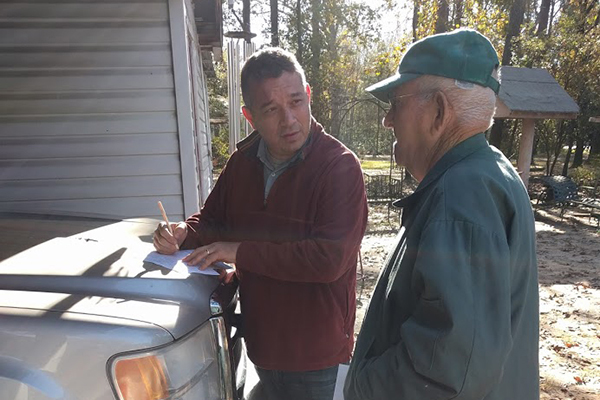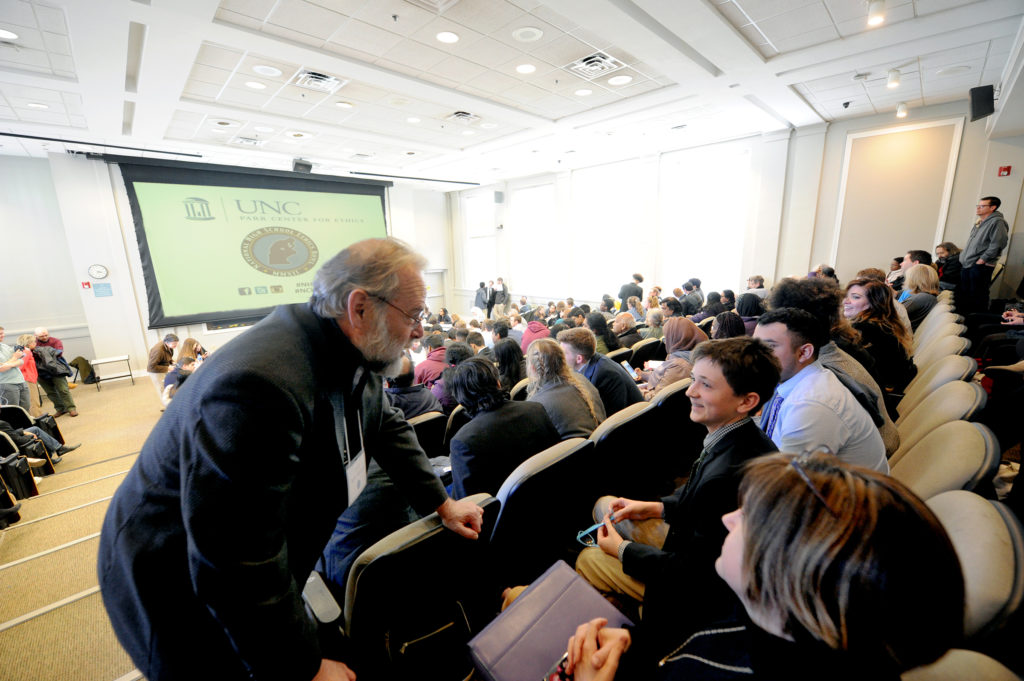This past semester, Annie McDarris participated in a capstone class through the Environment, Ecology, and Energy Program that examined well water contamination and environmental justice in the northern piedmont of North Carolina. She is a part of the Environment and Science Communication Dual Degree Program’s class of 2020.

On September 14, 2018, Hurricane Florence swept ashore near Wrightsville Beach and set off on a warpath that curved up and around the Carolinas. Although the storm spared the North Carolina piedmont from the worst of the damage, heavy rains brought flooding that lasted for weeks. As communities were still recovering, Tropical Storm Michael barreled towards North Carolina and a second round of intense flooding ensued. The double-punch of storms left people across the state reeling, and homes and property were destroyed or damaged.

Property damage wasn’t the only concern. An estimated 3.3 million North Carolinians – 15 percent of the state – rely on groundwater wells for drinking, bathing, and cooking. Many people who were affected by flooding feared that the water, which in some places carried industrial runoff, hog waste, or other contaminants, could have polluted their wells.
That concern, however, is something that researchers from the University of North Carolina at Chapel Hill and Virginia Tech anticipated. Before Florence even made landfall, UNC’s Kathleen Gray and Andrew George, along with Virginia Tech’s Kelsey Pieper and Mark Edwards, were writing a grant proposal to test wells for contamination after the storm hit. Edwards and Pieper did similar work in Texas after Hurricane Harvey, and they hoped that post-storm research in North Carolina could help people and build off their previous study.
The team from the two universities has collected data on communities in New Hanover, Robeson, Iredell, and Chatham counties. The UNC researchers are focusing on engaging communities that are concerned about their well water and the Virginia Tech team is working on data analysis. Together they have amassed over a thousand samples through their emphasis on community-engaged research.
“UNC is a familiar and generally trusted name, and recognized as an objective scientific leader,” says Gray, who is the director of the Institute for the Environment’s Center for Public Engagement with Science. “Engaging so many people in environmental science in their home community is going to encourage more conversation, more participation, and a greater recognition of these issues.”
To participate in the study, residents of communities affected by the storms collect water samples from their faucets and wells and drop them off at designated locations. After Virginia Tech analyzes the samples, the researchers report back to the communities with their findings and answer any questions.
Through this process, they can receive around 70 tests in one day. On one occasion in Iredell County, 800 people showed up, prompting assistance from highway patrol to help with traffic flow.
This high turnout is groundbreaking in well water testing in North Carolina. When the Chatham County Health Department offered free well testing for those who lived half a mile to a mile away from a coal ash landfill, less than ten people took the county up on the offer.

“When we collect the water sample with the local health department, it becomes public record,” Anne Lowry, the environmental health director for Chatham County, says. “Anyone can have access to what’s in that water… These are assumptions, but if you find out you have a contaminated well, but you have no money to address the contamination, sometimes you don’t want to know about the contamination to begin with. And it can impact your property value.”
As the Community Engagement Coordinator for IE, George spends a lot of time in affected communities talking to residents and helping raise awareness about the study and the importance of testing well water. He studies environmental justice and well water contamination across the state. He’s an affable guy, and walks and talks in a way that feels casual and fun compared to the straight-laced façade of a stereotypical scientist. He says “cool” a lot and calls everyone he likes a “rock star.”
“Andrew’s been really open with us about his study that’s taking place right now,” Lowry says. “Our goal is to get people to sample their wells. So we’re excited that they’re having this study here.”
The Virginia Tech and UNC researchers are taking extra steps to ensure the privacy of people who come to find out their water is contaminated. This meant obtaining a Certificate of Confidentiality from the National Institutes of Health, which protects participants’ identifies and personal data, even in court.
The issue of water contamination is something that has no easy fix and requires scores of research to pin down in the first place. Wells are not regulated in the way that municipal systems are, so there is no guarantee that the water that a person or family is consuming is safe. And in many regions of the country, including North Carolina, there is evidence that wells – particularly in communities of color or of low socioeconomic status – are contaminated.
Lead and arsenic are of particular concern, as is hexavalent chromium – also known as chromium six – a carcinogen that can cause stomach cancer, pneumonia, complications during childbirth, and skin burns. There are no federal safety standards for it, but awareness is on the rise.
“We found that in every one of these communities,” George says.
These issues may not derive from a specific source. North Carolina’s piedmont lies along the Carolina Slate Belt, a thin band of volcanic rock that runs from east of Charlotte up through Burlington and Asheboro. A study conducted by Duke University found that the slate bedrock is rich in chromium six, and another by researchers at the Gillings School of Global Public Health found similar results regarding arsenic.
But the post-storm study isn’t looking to find a source of the well water contamination, but rather to provide residents an analysis of their water and ensure that they are knowledgeable about what they’re consuming.
“From my perspective, the most important question is, ‘Are people drinking it? Are our kids drinking it?’ and then, ‘Are there solutions to prevent them from being exposed to what’s in their water?’” George says.
He stresses that it is important to understand the extent, spread, and severity of widespread well water contamination without waiting to identify potential sources.
One community that has been involved in the study is Moncure, a tiny municipality in Chatham County along Old US Highway 1. Fifty-three percent of residents are on well water.
In early March, a bit outside of town in the Liberty Chapel Church near the Haw River, George held a well clinic for people to come and drop off their well samples. About thirty samples sat in a cardboard box in the church annex’s kitchen, all labeled and accompanied by a short survey that the well owner filled out. There was another clinic going on in nearby Pittsboro, but George ran out of the 100 sampling kits to give out and had to ask some people to return another day.
Some of George’s undergraduate students were there, watching and smiling as people trickled in to drop off their samples. They were with George to see the front end of data collection, since they were working on a separate research project about well water contamination in the northern piedmont of North Carolina.
The nine students, which George taught through one of the Environment, Ecology, and Energy Program’s undergraduate capstone classes, worked to assess the severity of well water contamination in Alamance, Person, Caswell, Durham, and Orange counties during the spring semester.
“Before this class, I really didn’t know anything about water contamination,” Anna Moser, a senior environmental studies major, says. “I especially didn’t know that it was an issue in North Carolina.”
Moser contributed her skills in GIS, or geographic information systems, to the project. With GIS, she and a small team were able to create maps that represented their geographic data visually. The team worked hard to use its skills to parse out where contamination was and what factors—such as race, education, and income – may influence its distribution.
“It’s nice to be able to apply the things that I’ve learned in my courses with my own data, rather than with data that’s already been simulated for the purpose of a lab,” she says. “It’s real world stuff.”
Moser said that she enjoyed the class and George as a professor.
“He’s been great,” she says. “I think he’s super encouraging of his students and obviously really passionate about the subject matter. He really cares about getting his students involved in environmental justice issues, but also in helping his students accomplish their own personal career goals.”
The going was tough, sometimes, but the class persevered. On April 26, they shared their findings during a presentation with other capstone classes. They found that African American and Hispanic populations had higher lead levels in their water in the northern piedmont of North Carolina than other populations, a finding that established research backs up. They also found that manganese, a metal that the federal government regards as a nuisance rather than a danger, is found above federal standards in 30-42 percent of the wells tested.

The class also found something new. Their analysis uncovered a relationship between chromium and income, something not found in previous studies. The class recommended that more research is needed, and more wells tested, to better understand the results.
The study involving storm-affected communities is ongoing, and people are still submitting their well water to be tested. Until communities receive their results, the researchers are tight-lipped about what they’re finding. They presented to Iredell County on April 18 and are preparing a similar discussion with residents of Chatham County soon.
Luckily, in Iredell County, lead and hexavalent chromium levels did not appear to be unusually high after the storm, but both are present in the water at levels that aren’t great, but not unexpected in wells.
Finding out what’s in the water is certainly helping communities, but the communities are also helping the researchers hone research topics that address their needs.
“The communities are definitely benefiting the science,” Gray says. “You get richer and maybe more relevant questions. And then there’s just an exciting aspect to interacting with people for whom the science is really relevant.”
Pieper, Edwards, Gray, and George hope that what they’re finding will help North Carolinians make informed decisions about their drinking water, and potentially inform storm preparation and response in the future.
“People are focused. They want answers, and they believe the university is a good partner to help them get the information that they desperately want and need,” Gray says. “And they are full of energy and hope and optimism for solutions. It’s part of what makes our work so gratifying.”
By Annie McDarris ’20, Institute for the Environment



